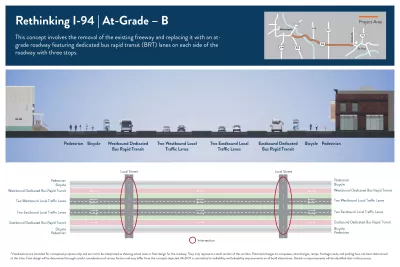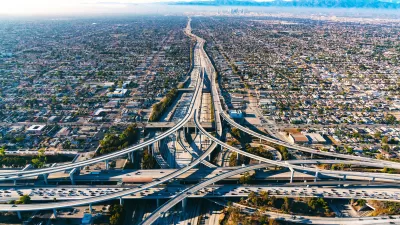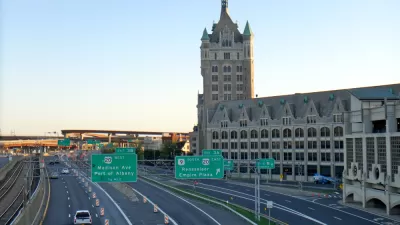Two new proposals for replacing the freeway with at-grade segments offer new visions for the future of downtown Minneapolis.

“In mid-July, the Minnesota Department of Transportation rolled out a slate of 10 design alternatives for the future of a 7.5-mile stretch of Interstate 94 that runs between Minneapolis and St. Paul, including two options that would bring the highway to grade and convert it into a boulevard, which won the most community support in early public meetings.” Writing in Streetsblog, Kea Wilson explains the controversy around the project.
The new proposals to tear down the road contradict previous assessments that removal wouldn’t be possible. “For local non-profit Our Streets Minneapolis, though, thoroughly reimagining I-94 isn't just the best option on the table — it's the only option if the Land of 10,000 Lakes truly wants to reckon with the racist legacy of its transportation choices.”
Our Streets wants MnDOT to go even further and adopt “a more ambitious concept they're calling Twin Cities Boulevard, which would incorporate subways, extend a major greenway, and expand the project area to include other adjacent highways that the group says would be ripe for repurposing if I-94 were removed.”
Other groups support the proposed “Rondo Community Land Bridge, a 16-acre cap that would leave the highway intact, but establish a cultural enterprise district aimed at restoring intergenerational wealth to African-American Minnesotans atop it.” This proposal received a $2 million Reconnecting Communities grant for research and planning.
“One thing both advocacy groups can agree on, though, is that like urban highways in virtually every city in America, I-94 has had a catastrophic impact on the Twin Cities' most marginalized — and its next chapter must be a catalyst for change.”
FULL STORY: Twin Cities Advocates Split Over What’s Possible for Their Downtown Highway

Study: Maui’s Plan to Convert Vacation Rentals to Long-Term Housing Could Cause Nearly $1 Billion Economic Loss
The plan would reduce visitor accommodation by 25,% resulting in 1,900 jobs lost.

North Texas Transit Leaders Tout Benefits of TOD for Growing Region
At a summit focused on transit-oriented development, policymakers discussed how North Texas’ expanded light rail system can serve as a tool for economic growth.

Using Old Oil and Gas Wells for Green Energy Storage
Penn State researchers have found that repurposing abandoned oil and gas wells for geothermal-assisted compressed-air energy storage can boost efficiency, reduce environmental risks, and support clean energy and job transitions.

Private Donations Propel Early Restoration of Palisades Playground
Los Angeles has secured over $1.3 million in private funding to restore the Pacific Palisades playground months ahead of schedule, creating a modern, accessible space that supports community healing after recent wildfires.

From Blight to Benefit: Early Results From California’s Equitable Cleanup Program
The Equitable Community Revitalization Grant (ECRG) program is reshaping brownfield redevelopment by prioritizing projects in low-income and environmental justice communities, emphasizing equity, transparency, and community benefits.

Planting Relief: Tackling Las Vegas Heat One Tree at a Time
Nevada Plants, a Las Vegas-based nonprofit, is combating the city’s extreme urban heat by giving away trees to residents in underserved neighborhoods, promoting shade, sustainability, and community health.
Urban Design for Planners 1: Software Tools
This six-course series explores essential urban design concepts using open source software and equips planners with the tools they need to participate fully in the urban design process.
Planning for Universal Design
Learn the tools for implementing Universal Design in planning regulations.
Ascent Environmental
Borough of Carlisle
Institute for Housing and Urban Development Studies (IHS)
City of Grandview
Harvard GSD Executive Education
Toledo-Lucas County Plan Commissions
Salt Lake City
NYU Wagner Graduate School of Public Service





























